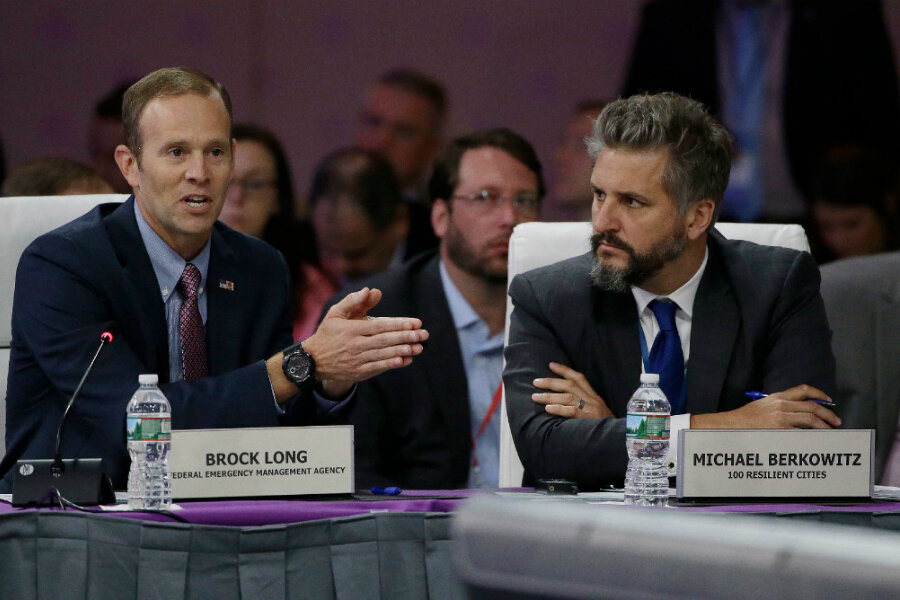Growing cities take proactive stance against diverse threats, building resilience
Loading...
| Tepic, Mexico
Urban resilience, no longer just a buzzword, is fast becoming part of the fabric of cities around the world, which need to ramp up strategies to ensure the wellbeing of their booming populations in the face of growing threats, experts say.
Developing new technologies and flexible financing, and finding nimble ways to operate are needed for cities to take the lead in tackling diverse issues such as climate change, transport, and housing.
"Cities are so important as they're the center of innovation on one side, and they're also the concentrations of the largest populations," said Arnoldo Matus Kramer, chief resilience officer for Mexico City, home to more than 21 million people.
"The behavioral change we need ... to be more resilient societies will come from cities."
Organized by the Rockefeller Foundation-backed 100 Resilient Cities (100RC) network, a four-day meeting of urban experts in New York starting on July 24 will look at ways to cope with challenges including extreme weather and migration.
Cities from London to Lagos, San Francisco, to Seoul have signed up to 100RC's $164 million effort in a bid to strengthen their resilience as cities continue to swell.
The United Nations predicts 66 percent of the world's population will live in cities by 2050, up from 54 percent in 2014.
For many cities, top of the list of challenges are protecting urban populations better from hazards like flooding, heat waves, hurricanes, and earthquakes, improving housing and basic amenities, reducing crime and inequality, and expanding green transport.
Although cities – which generate 80 percent of global economic output – may face similar kinds of problems, resources and central government policies determine how fast they can press ahead and the impact of their actions, said experts.
In the United States, hundreds of cities have pledged to work with states and businesses toward achieving the Paris climate agreement goals, sidestepping President Trump's decision to pull the country out of the pact agreed to by nearly 200 countries and aimed at curbing greenhouse gas emissions.
"We're seeing cities increasingly playing a role because other levels of government aren't responding fast enough," said Robin King of the World Resources Institute's Ross Center for Sustainable Cities.
In Latin America – where over four-fifths of people live in urban areas – cities should look ahead and nail down long-term plans and projects that can open the door to financing, said Manuel Olivera, Latin America regional director for C40, a network of cities working to address climate change.
"Cities are needing to work faster in terms of resilience," he said.
Many are simultaneously trying to tackle every-day problems as they appear, while giving some priority to projects related to climate change, he added.
Business Partner
In Asia, cities such as Dhaka and Colombo are now "looking beyond the doom of climate change," and investing more proactively in measures to reduce risk such as early warning systems and flood protection, said Marc Forni, a specialist in disaster risk management with the World Bank.
"The challenge is designing and preparing investment packages that are comprehensive, that are large scale," he said.
"It's making those types of cases to cities that investment in resilience leads to positive growth and value creation."
Innovative financing such as green bonds and greater use of disaster insurance could help more cities cover costs but with trillions of dollars needed to be spent on urban infrastructure in the coming decades, they must enlist the private sector to fill the gap, said experts.
"The more you can treat (a) responsible private sector as a real true, full-fledged partner, the better your outcomes will be," said Michael Berkowitz, president of 100 Resilient Cities.
"It is a fine line because in many, many places around the world, corruption is a real issue, so politicians are either wary about being perceived (as) too close or unable, for rules and regulations, to bring the private sector in."
Mayors must ensure investments are pragmatic, designed to save costs, cut the likelihood of disasters striking, and help residents recuperate faster in the event of an emergency, said experts.
Katharine Burgess of the Urban Land Institute said the concept of urban resilience is "here to stay."
"It's not just about being more prepared – it's about building a stronger city with higher quality of life and better economic development opportunities," she said.







